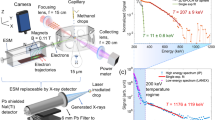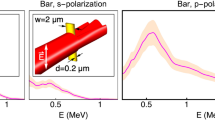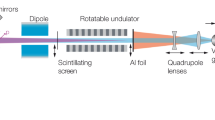Abstract
The ability to confine and store optical energy in small volumes has implications in fields ranging from cavity quantum electrodynamics to photonics. Of all cavity geometries, micrometre-sized dielectric spherical resonators are the best in terms of their ability to store energy for long periods of time within small volumes1. In the sphere, light orbits near the surface, where long confinement times (high Q) effectively wrap a large interaction distance into a tiny volume. This characteristic makes such resonators uniquely suited for studies of nonlinear coupling of light with matter. Early work2,3 recognized these attributes through Raman excitation in microdroplets—but microdroplets have not been used in practical applications. Here we demonstrate a micrometre-scale, nonlinear Raman source that has a highly efficient pump–signal conversion (higher than 35%) and pump thresholds nearly 1,000 times lower than shown before. This represents a route to compact, ultralow-threshold sources for numerous wavelength bands that are usually difficult to access. Equally important, this system can provide a compact and simple building block for studying nonlinear optical effects and the quantum aspects of light.
This is a preview of subscription content, access via your institution
Access options
Subscribe to this journal
Receive 51 print issues and online access
$199.00 per year
only $3.90 per issue
Buy this article
- Purchase on Springer Link
- Instant access to full article PDF
Prices may be subject to local taxes which are calculated during checkout




Similar content being viewed by others
References
Collot, L., Lefevre-Seguin, V., Brune, M., Raimond, J. M. & Haroche, S. Very high-Q whispering-gallery mode resonances observed on fused silica microspheres. Europhys. Lett. 23, 327–334 (1993).
Qian, S. X. & Chang, R. K. Multiorder Stokes emission from micrometer-size droplets. Phys. Rev. Lett. 56, 926–929 (1986).
Lin, H. B., Huston, A. L., Eversole, J. D. & Campillo, A. J. Double-resonance stimulated Raman-scattering in micrometer-sized droplets. J. Opt. Soc. Am. B 7, 2079–2089 (1990).
Braunstein, D., Khazanov, A. M., Koganov, G. A. & Shuker, R. Lowering of threshold conditions for nonlinear effects in a microsphere. Phys. Rev. A 53, 3565–3572 (1996).
Knight, J. C., Cheung, G., Jacques, F. & Birks, T. A. Phase-matched excitation of whispering-gallery-mode resonances by a fiber taper. Opt. Lett. 22, 1129–1131 (1997).
Chang, R. K. & Campillo, A. J. (eds) Optical Processes in Microcavities (World Scientific, Singapore, 1996).
Gorodetsky, M. L., Savchenkov, A. A. & Ilchenko, V. S. Ultimate Q of optical microsphere resonators. Opt. Lett. 21, 453–455 (1996).
Weiss, D. S. et al. Splitting of high-Q Mie modes induced by light backscattering in silica microspheres. Opt. Lett. 20, 1835–1837 (1995).
Lai, H. M., Leung, P. T., Young, K., Barber, P. W. & Hill, S. C. Time-independent perturbation for leaking electromagnetic modes in open systems with application to resonances in microdroplets. Phys. Rev. A 41, 5187–5198 (1990).
Zhang, J. Z. & Chang, R. K. Generation and suppression of stimulated Brillouin scattering in single liquid droplets. J. Opt. Soc. Am. B 6, 151–153 (1989).
Cai, M., Painter, O. & Vahala, K. J. Observation of critical coupling in a fiber taper to a silica-microsphere whispering-gallery mode system. Phys. Rev. Lett. 85, 74–77 (2000).
Lin, H. B. & Campillo, A. J. CW nonlinear optics in droplet microcavities displaying enhanced gain. Phys. Rev. Lett. 73, 2440–2443 (1994).
Ilchenko, V. S. & Gorodetskii, M. L. Thermal nonlinear effects in optical whispering gallery microresonators. Laser Phys. 2, 1004–1009 (1992).
Vernooy, D. W., Ilchenko, V. S., Mabuchi, H., Steed, E. W. & Kimble, H. J. High-Q measurements of fused-silica microspheres in the near infrared. Opt. Lett. 23, 247–249 (1998).
Bachor, H.-A., Levenson, M. D., Walls, D. F., Perlmutter, S. H. & Shelby, R. M. Quantum nondemolition measurements in an optical-fiber ring resonator. Phys. Rev. A 38, 180–190 (1988).
Silberhorn, Ch. et al. Generation of continuous variable Einstein-Podolsky-Rosen entanglement via the Kerr nonlinearity in an optical fiber. Phys. Rev. Lett. 6, 4267–4270 (2001).
Treussart, F. et al. Evidence of the intrinsic Kerr bistability of high-Q microsphere resonators in superfluid helium. Eur. Phys. J. D 1, 235–238 (1998).
Fan, X., Palinginis, P., Lacey, S., Wang, H. & Lonergan, M. C. Coupling semiconductor nanocrystals to a fused-silica microsphere: a quantum-dot microcavity with extremely high Q factors. Opt. Lett. 25, 1600–1602 (2000).
Acknowledgements
We thank A. D. Stone and R. K. Chang for comments. This work was supported by DARPA, NSF and the Caltech Lee Center.
Author information
Authors and Affiliations
Corresponding author
Ethics declarations
Competing interests
The authors declare no competing financial interests.
Rights and permissions
About this article
Cite this article
Spillane, S., Kippenberg, T. & Vahala, K. Ultralow-threshold Raman laser using a spherical dielectric microcavity. Nature 415, 621–623 (2002). https://doi.org/10.1038/415621a
Received:
Accepted:
Issue Date:
DOI: https://doi.org/10.1038/415621a
This article is cited by
-
Ultrashort dissipative Raman solitons in Kerr resonators driven with phase-coherent optical pulses
Nature Photonics (2024)
-
High quality factor metasurfaces for two-dimensional wavefront manipulation
Nature Communications (2023)
-
Widely-tunable, multi-band Raman laser based on dispersion-managed thin-film lithium niobate microring resonators
Communications Physics (2023)
-
Conformal optical black hole for cavity
eLight (2022)
-
Broadband high-Q multimode silicon concentric racetrack resonators for widely tunable Raman lasers
Nature Communications (2022)
Comments
By submitting a comment you agree to abide by our Terms and Community Guidelines. If you find something abusive or that does not comply with our terms or guidelines please flag it as inappropriate.



